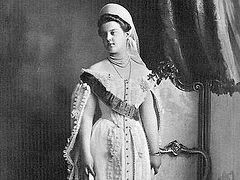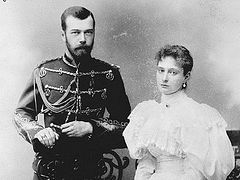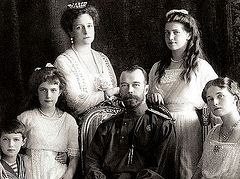When we look at the life of holy Royal Passion-Bearers, their podvig as a family strikes us most. Truly, they succeeded in embodying the Christian family ideals on the earth and bringing up their daughters and son in it like nobody else. And, of course, it was from their wise parents that the saints, like “most honorable branches of the pious root” (from the service to Right-Believing Prince Alexander Nevsky), received the rudiments of what later blossomed forth and led them to heavenly abodes.
Many monarchs married for love, but few and far between are those who managed to preserve it for the rest of their lives, multiply it and pass it on to their children, while striving for spiritual perfection and mercy. And it is no coincidence that the last Russian Emperor and his consort came from such families.
The mid-nineteenth century saw the weddings of two couples whose children were destined to go down in history and be ranked among the saints. In 1862, Princess Alice of the United Kingdom and Grand Duke Louis IV of Hesse married in the UK. Four years later in 1866, in Russia, Crown Prince Alexander III of Russia married Princess Dagmar of Denmark. Both dynastic marriages were concluded on the basis of mutual attraction.
Louis IV and Alice of Hesse: holiness as the cornerstone of education
 The family of Grand Duke Louis IV of Hesse and by Rhine, 1876 Princess Alice, the mother of the last Russian Tsarina, grew up in the large and loving family of Queen Victoria of Great Britain and Ireland and Prince Albert. Of all their children, Alice was the most sensitive and compassionate and always strove to relieve someone else’s pain. It was she who at the age of eighteen alleviated the suffering of her dying grandmother [Princess Victoria, Duchess of Kent (1786—1861), her maternal grandmother.—Trans.], spending much time at her deathbed. Queen Victoria, who had married for love, wanted the same for her children. Princess Alice and Duke Louis looked forward to their wedding ceremony, but the young princess’ happiness was clouded by the premature death of her beloved father, Prince Albert, shortly before the wedding. And again Alice, “the angel of their family,” attended on her father to the end, and supported her mother.
The family of Grand Duke Louis IV of Hesse and by Rhine, 1876 Princess Alice, the mother of the last Russian Tsarina, grew up in the large and loving family of Queen Victoria of Great Britain and Ireland and Prince Albert. Of all their children, Alice was the most sensitive and compassionate and always strove to relieve someone else’s pain. It was she who at the age of eighteen alleviated the suffering of her dying grandmother [Princess Victoria, Duchess of Kent (1786—1861), her maternal grandmother.—Trans.], spending much time at her deathbed. Queen Victoria, who had married for love, wanted the same for her children. Princess Alice and Duke Louis looked forward to their wedding ceremony, but the young princess’ happiness was clouded by the premature death of her beloved father, Prince Albert, shortly before the wedding. And again Alice, “the angel of their family,” attended on her father to the end, and supported her mother.
The Duchess Consort of Hesse found her true mission in family life and bore seven children to her spouse. She supported her husband as much as she could and did her very best to help the sick and wounded during the Austro-Prussian War, despite her pregnancy. It was then that Alice made friends with the famous nurse and medical reformer Florence Nightingale, and became her follower.
Alice loved medical and social work sincerely and not just formally, and involved her children in it too.
She shared her charitable nature with her daughter. As it turned out, it was the best “dowry” for the princesses of the Duchy of Hesse (who was not rich), who lived by the strict Victorian rules in a house where personal money was spent on charity. Their children dressed very modestly, and often travelled on foot; their hands were always busy with handiwork, and their duties included visiting hospitals, bringing flowers for patients. Apart from physical development, their very religious mother paid special attention to their spiritual and intellectual growth.
As her mother, Queen Victoria, wrote, Alice had “a self-sacrificing character and a fearless and all-consuming devotion to duty.”
Princess Alice truly gave her life to her family, contracting diphtheria while caring for her sick children. After her death [in 1878 at aged thirty-five.—Trans.] newspapers called Alice “a model of family virtue and boundless mercy”, and her fellow-countrymen called her “the royal angel”, just as her second daughter, Elizabeth the New Martyr, would be called “Moscow’s white angel” in Russia. And even ill-wishers would bow their heads before “the family hearth” of her youngest daughter Alix (St. Alexandra Feodorovna), who was named after her mother.
“My mother was among those great souls who… attained a high level of perfection. And all the people I spoke to noted that they were transformed under the influence of her personality,” wrote Ernest Louis, Alice’s oldest son.
It was said of Duke Louis, their father, that he loved his children dearly and was kind-hearted by nature, a trait that allowed him to influence them not by edifying but by providing the personal example of his life. The kids adored their father, often spending time in his office, drawing and playing there while he was busy with his papers.
They showed profound respect for their father for the rest of his life. The letters and diaries of Elizabeth Feodorovna and Alexandra Feodorovna in their adulthood indicate how much their “Papa” meant for them and how much they feared upsetting him. It was the fear of disappointing her father that made Grand Duchess Elizabeth delay in joining the Orthodox Church: “I ask, I ask you to forgive your daughter after receiving these lines if she hurts you,” she wrote. Alix, the youngest princess who lost her mother very early, was particularly close to him. In her girlhood she would often spend much time in her “Papa’s” house with him, was concerned about his interests, and was his closest friend in the final years of his rule.
Alexander III and Maria Feodorovna: a unity of opposites
 The last family photograph in Livadia. May 1893. The wedding of the last Russian Tsar’s parents also took place after a tragic event. When Crown Prince Nicholas [Alexander III’s elder brother, who died in 1865.—Trans.] died, Alexander, who had loved him dearly, became the heir apparent and married Nicholas’ fiancée, Princess Dagmar. It was said that their mutual sincere affection for Nicholas drew them together and that on his deathbed the dying Tsesarevich united their hands.
The last family photograph in Livadia. May 1893. The wedding of the last Russian Tsar’s parents also took place after a tragic event. When Crown Prince Nicholas [Alexander III’s elder brother, who died in 1865.—Trans.] died, Alexander, who had loved him dearly, became the heir apparent and married Nicholas’ fiancée, Princess Dagmar. It was said that their mutual sincere affection for Nicholas drew them together and that on his deathbed the dying Tsesarevich united their hands.
Outwardly, that couple resembled Alexandra Feodorovna’s parents: an imposing and strong husband and a small and fragile wife. The future Emperor Alexander III adored and pampered his little “Minnie” (i.e., Maria Feodorovna), for which she became his obedient and loving spouse. What could be better for someone who had for many years seen his father’s double life [Princess Catherine Dolgorukov (1847—1922) was Alexander II’s mistress from 1866 and his morganatic wife after Empress Consort Maria Alexandrovna’s death in 1880.—Trans.] and the humiliations that his beloved mother had to bear. In all probability it was at that time that the Crown Prince decided to become a faithful husband and a good family man. And he became one. He enjoyed family life throughout his twenty-eight years of his marriage, saying:
“May God bless everybody with a wife like mine—then they will feel untroubled and happy.”
Maria Feodorovna was the worthy wife of Alexander III—first when he was heir to the throne and then Emperor—and the caring mother of their six children. Everybody at the court came to love her immediately; in any society she would leave a great impression by her generosity, sincerity and femininity. Maids of honor were amazed by the fact that she peeled potatoes and darned her husband’s clothes herself. She was also involved in acts of charity by heading Empress Maria’s Department of Institutions, which comprised educational establishments, foundling hospitals, orphanages and almshouses.
The royal spouses tried never to be apart, and after the birth of their children, spending time together in the family circle became their favorite pastime. Alexander III was a loving, strict yet fair father. It was said that not only did he never lay a finger on his kids, he even never hurt them by any hard words. This is how he instructed the governess of his oldest sons:
“Neither I nor the Grand Duchess wish to raise hothouse plants instead of children. <…> They should pray hard to God, study sciences, play usual children’s games, and be naughty within reasonable limits. <…> I do not need marble—I need normal Russian children.”
Duchess Alice of Hesse, Alexandra Feodorovna’s mother, adhered to the same principles in bringing up children:
“I try to instill in them that it doesn’t befit them to be haughty because of their standing… so that princes and princesses should know that they are neither better nor higher than others at all and that they should set everybody a good example by their kindness and modesty.”
The future Emperor Nicholas II, like his consort, had a very “English” education, with rather Spartan conditions, responsibilities and duties. Later they applied much of that in bringing up their own holy children.
Maria Feodorovna entertained the children by seating them (one after another) on the train of her dress and “rolling” them on the parquet floor. And she demonstrated tact by doing this with the governess’s child (who grew up together with the princes) before the other children. The Empress consort was not only the perfect mother (she could find a common language with any child), but also the leader in children’s games and pranks. Thus, once in a zoo she fought with a monkey for her bonnet, much to the kids’ amusement. Another time she came to an important meeting with a black eye and said in a simple manner:
“Don’t worry, friends! I have just been to the skating-ring with the kids. We skated together and I fell there!”
The Emperor would spend a couple of hours with the children on an outing every day. He was able to “read” animals’ tracks, build model fortresses, and play war games; he taught the children how to clear paths, fell dead trees and make bonfires, inspiring his offspring’s admiration and love. With each of his children he had a private little secret that was unknown to the others. Thus, together with “Nicky” (the future Nicholas II) they wrote “a dog’s story.” Apart from that, every evening the kids were invited to their father’s office, where, without holding anything back, they were asked to reveal all good and bad things that had happened to them during the day and assess their own behavior.
It can also be said of the father of the last Russian Emperor that he laid down his life for his family. During the Borky Train Disaster, when the Imperial train was derailed at high speed, Alexander III held the collapsed roof of the royal car on his shoulders until his family escaped the crash side. That incident was believed to have caused the premature death of the Emperor, who had had Herculian strength. Empress-dowager Maria outlived him by many years. Their youngest daughter Olga would say about her parents’ family:
“My parents had so little in common, yet no one could have ever wished a happier marriage.”




